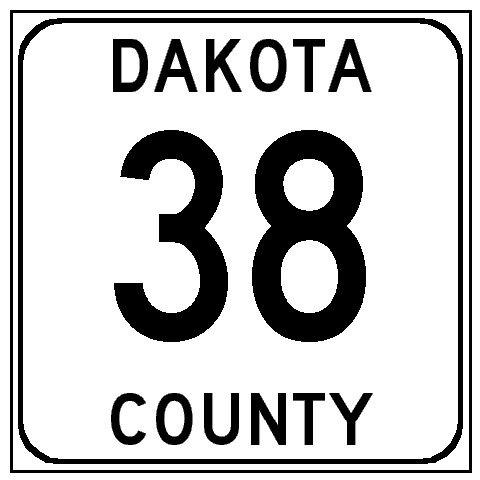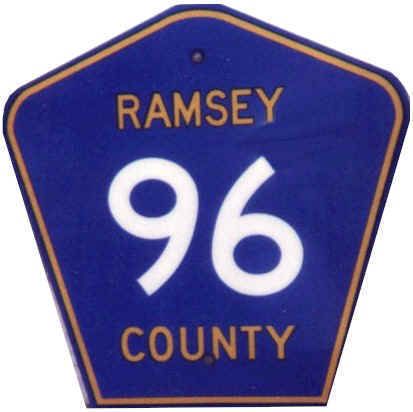County Highway Systems
| Traveling rural roads through Minnesota
is easier than in most states because every Minnesota
county has a numbered route system. With very few
exceptions, all county routes have numbers, not letters
or alphanumeric combinations*. Numbers are unique only
within a county. County roads fall into two categories:
County State-Aid Highways (abbreviated CSAH) and County
Roads. Construction and maintenance of a CSAH is funded
partially from the Highway Users Fund that is derived
from the state gasoline tax, while County Roads are
funded strictly from local county funding sources. County
highways are marked with one of two designs of sign: the
old square, black on white sign, and the newer blue
pentagonal marker that is in common use throughout the
country. Some counties use one or the other exclusively,
or may use the pentagonal sign to indicate primary county
routes (but not generally as a distinction between County
State-Aid Highways and County Roads). This extensively
numbered county highway system provides an additional
navigational aid using secondary routes throughout the
state, with the only problem being that numbers tend to
change at the county line. (An "Intercounty"
route marking system is used in a few areas, with a
rectangular blue sign under the county route marker,
designated with a letter that does not change at the
county line. Unfortunately, this "Intercounty"
designation is not marked on any maps, thus limiting its
usefulness.)
*Contrary to popular belief, Ramsey County does not
have lettered county routes. There is a series of roads
named "County Road B" through "J" at
one-mile intervals, but this is not the official marked
designation. Each of these has a separate, and usually
marked number (for example, County Road E is marked
Ramsey County 15). These street names are vestiges of an
old numbering system that was revised by around 1960.
|


|
County markers on guide signs (green background signs used on
freeways and other main roads) differ from confirmation markings
in that the name of the county is omitted and the legend
"COUNTY" is moved to the top of the number. Both the
square white and pentagonal blue county signs are depicted in
this way at freeway exits and expressway junctions. Actually, the
only places one sees the blue pentagonal signs on
freeway/expressway guide signs are in the outstate counties of
Stearns and Wright, and the Metro counties of Anoka, Hennepin,
Ramsey, Scott, Washington and Dakota.
County State-Aid Highways are found in unexpected places, and
span a wide variety of road types. In the Twin Cities metro area,
for instance, there are marked Hennepin County routes in downtown
Minneapolis. Hennepin CSAH 81 and CSAH 152 from the northwest
suburbs into Minneapolis are major feeder routes, classified as
A-minor arterials, that carry large volumes of traffic.
Contrasting this, Anoka CSAH 4 is mostly carried through Columbia
Heights on 49th Avenue NE, which is merely a residential
collector street (classified as either a B-minor arterial or
collector). Quite a contrast for roads with the same route
classification.
Shifts in highway
jurisdiction
Currently, there are about 12,000 miles authorized in the
trunk highway system. This is the limit on mileage authorized by
the Minnesota Constitution. The actual total mileage in the
system has been slowly decreasing the past few years. MnDOT is
gradually turning back trunk highways that would more
appropriately be under county or local jurisdiction because they
serve a more local function. This trend is most evident in the
Twin Cities metropolitan area; before construction of the
Interstate system, there were numerous city streets that carried
a state trunk highway designation. Today, most such streets have
been turned back to county or city control, and except for a few
major connecting streets (most of which connect to highways
feeding into the metropolitan area), most trunk highways in the
metropolitan area are Interstate or state freeways. MnDOT's Metro
District has a long-term plan to turn back all roads that are not
Principal Arterials to local control, and to take control those
Principal Arterials that are under county or city control. Those
routes are Main Street (Anoka CSAH 14) betwen TH-65 and I-35W;
Shephard and Warner Road in St. Paul between I-35E and U.S. 61;
and Dakota and Scott CSAH 42 and Scott CSAH 18. No timetable has
been set for the turnbacks or new route acquisitions, though the
Metro District's Transportation System Plan is currently being
revised and may provide some insight into the timing.
No new trunk highways have been authorized in Minnesota in the
past six years or so, and each year probably 10 to 20 miles of
trunk highway are turned back to the counties. One
significant act that underscored this trend was the MnDOT-Hennepin
County Highway Swap of 1988.
In 1988 MnDOTand Hennepin County (which includes the city of
Minneapolis and a large area west of that city) negotiated a
major swap of highway jurisdiction, in which MnDOT assumed
control of county freeways CSAH 18 and 62 (then called "The
Crosstown"), and in return Hennepin County assumed control
of many miles of surface roads under state control. The
legislature had previously authorized special routes that allowed
MnDOT to assume control of these routes. CSAH 18 became U.S. 169,
and CSAH 62 became MN-62. All remaining signs indicating
"Crosstown" came down on 62 as the new state route
markers went up, though this name is still used by long-time
residents to confuse newcomers. In exchange for about 40 miles of
two to four-lane roads that are mostly local or regional feeders,
MnDOT took over about 27 miles of four-lane freeway.
Possible future turnbacks (metro area only). Routes
throughout the metro area that are prime candidates for future
deletion from the trunk highway system are listed below. Routes
marked planned are likely to be in the 2001 Metro
District Transportation System Plan as turnback routes. This
indicates that discussions have occurred with the counties that
would take these routes over and the timing and improvements
needed will be negotiated. Routes marked potential are
routes for which no agreement have been reached, and/or routes
that have technical issues (such as being Constitutional Routes).
MN-5
east of MN-55 all the way to MN-36
(planned)
|
MN-13 east of
MN-55
(potential) |
MN-13
east of Cliff Road to MN-55
(future, if Cliff Road, the NHS segment, is added to
trunk highway system)
|
|
MN-47
south of I-694
(potential)
|
MN-51
(planned south of I-94)
|
U.S. 61
north of I-94
(planned in Ramsey County, potential in Chisago
County)
|
MN-65
south of I-694
(potential)
To be turned back in downtown Mpls (probably south of
Washington Ave) in 2001.
|
MN-96
(planned)
|
|
MN-149 (planned
in St. Paul, potential for part or all of rest of route)
|
MN-156 (planned
in St. Paul, potential for remainder of route)
|
U.S. 212
between Cologne and Eden Prairie after completion of new
freeway link (planned)
|
|
MN-291
(possible)
|
the unmarked
MN-952A (Robert St.), (planned
in St. Paul and potential south to I-494)
|
Deletion of some of these routes may be
contingent on maintaining required constitutional route
continuity. Some of these listings are my speculation, others
taken from county and metropolitan area transportation planning
documents.
Conversely, some routes will or are
suggested to be added to the system. These include the planned
but not yet funded U.S. 212 on its new alignment (a little piece
will be complete next year and temporarily signed MN-312) from
Cologne to Eden Prairie and MN-610 from I-94 to U.S. 169; and
county roads that are designated as "principal
arterials" by the Metropolitan Council such as CSAH 42 in
Scott and Dakota Counties (same road), which would connect to
U.S. 169 via CSAH 18; an extension of MN-77 along Cedar Avenue as
far as current CSAH 42; and an extension of MN-242 along CSAH 14
between MN-65 and I-35W in Anoka County. (However, MnDOT would
probably not agree to take over these routes without turnback of
a corresponding mileage of trunk highway to the counties
involved.)
Return to Minnesota Highways Home Page
| Originally
uploaded December 19, 1997 |
Last
updated December 28, 2003 |

